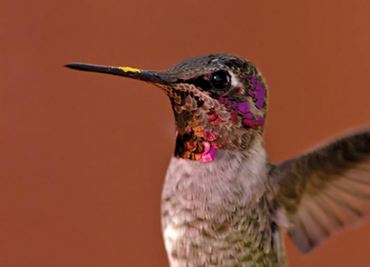
Hummingbirds may appear dainty because of their diminutive size, but these dazzling visitors to local gardens are bursting with energy. And they need to refuel often to maintain their dizzying blur of activity. But those who love hummingbirds are always sad when the birds leave for the winter. Or do they?
Devoted hummingbird fans are now learning otherwise. It’s true that the Rufuous hummingbirds that dominate summer feeders do, in fact, head south in mid-August. But more and more gardeners are discovering that if they keep their nectar feeders full, they can attract Anna’s hummingbirds and keep them coming all winter long.
Slightly larger than the Rufous, Anna’s hummingbirds like to nest at higher altitudes. But once the pugnacious Rufous hummers leave in the late summer or early fall, the Anna’s are happy to move to lower elevations, where the winter weather can be quite a bit milder. Anna’s populations are thriving as more and more people feed them. Kerry Hall reports seeing up to a dozen at a time at his Bainbridge Island feeders.
According to noted nature writer Connie Sidles, if people knew how feisty hummingbirds are, football teams would adopt them as mascots. Because of their agility in the air, they’ve been known to harass birds 10 times their size.
Making nectar is easy. Just combine clean water and ordinary table sugar in volumes of one part sugar to four parts water. Make sure containers are absolutely clean. If you decide to put out hummingbird feeders, however, be sure to keep them filled all winter long.
Once the hummingbirds become daily visitors, don’t leave them in the lurch during the colder winter months when they have few options and need to conserve energy. If you plan to travel during the winter, have someone keep your feeders filled when you’re away. They do visit multiple yards during the day just to check up on various feeders around their neighborhood. If someone’s feeder goes empty, the hummers will certainly come back to your yard more often.
During winter months you’ll also need to keep your feeders thawed. I bring mine in on subfreezing nights. I’m also watchful and ready to swap feeders if one needs to thaw. I bring them in around 7 p.m. and the little Anna’s that may be on the perch will scold me a bit with his or her chatter.
But you better get up early the next morning (5:30 – 6 a.m.) and put your feeder back up or they will be a little upset with you.
Hummingbirds are amazingly tough but vulnerable to extreme cold. They’ve even been observed sitting on a perch almost comatose because they have the ability to shut down if necessary to conserve energy. But they recover quickly as temperatures climb. At night they head into some heavy shrubbery to stay warm and out of the cold breezes and heavy rains.
They nestle near the trunk of the shrub and puff up their little bodies to create a sleeping-bag effect. Their feathers and down keep them warm and they lower their metabolism and drop their breathing and heart rate. They enter a torpor state and drop their body temperature to as low as 48 degrees.
There is a long-standing argument about whether we should feed birds at all. Let’s face it. We feed birds because we enjoy watching them, not because they need to be fed. They are fully capable of surviving on their own. But bird watching is a multibillion-dollar industry that stimulates the economy and provides countless jobs. It also provides endless enjoyment for millions of families with feeders in their backyards. Wildlife viewing links people more closely with nature. Those too elderly or disabled to tromp around in the forest can enjoy wildlife from home — even in the city. Some feeders can be attached to a windowsill and refilled from inside.
Leading wildlife advocates also recognize that bird watching and wildlife viewing heightens awareness of the importance of preserving and protecting wildlife and habitat. These pursuits help create a caring constituency for wildlife that will speak out when it is threatened. Environmentally, we’re all in this together and threats to our feathered friends affect us in ways we don’t always recognize.
So go ahead and enjoy feeding birds in your own backyard. They appreciate it, and it’s something the whole family can enjoy. Bird watching offers a wonderful window on wildlife and the boundless beauty of the natural world.
Gene Bullock of Kitsap Audubon Society contributed to this column.
























